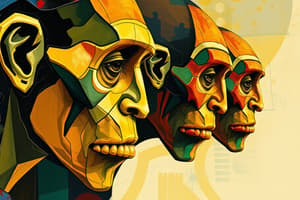Podcast
Questions and Answers
What percentage of DNA do humans share with chimpanzees and bonobos?
What percentage of DNA do humans share with chimpanzees and bonobos?
- 99% (correct)
- 95%
- 85%
- 90%
Homo sapiens emerged around 500,000 years ago.
Homo sapiens emerged around 500,000 years ago.
False (B)
Name one trait that Australopithecus afarensis and Homo erectus share.
Name one trait that Australopithecus afarensis and Homo erectus share.
Bipedalism or tool-making
Humans began domesticating wild plants and animals around __________ years ago.
Humans began domesticating wild plants and animals around __________ years ago.
Match the following key hominins with their notable characteristics:
Match the following key hominins with their notable characteristics:
What does Dr. Wu's braided stream analogy illustrate?
What does Dr. Wu's braided stream analogy illustrate?
Humans adapted to UV radiation by developing lighter skin in sunny areas.
Humans adapted to UV radiation by developing lighter skin in sunny areas.
What significant advancement in technology began approximately 2.5 million years ago?
What significant advancement in technology began approximately 2.5 million years ago?
Flashcards are hidden until you start studying
Study Notes
Evolution of Homo sapiens
- Homo sapiens emerged approximately 300,000 years ago.
- Early humans coexisted with at least three other close ape relatives, complicating the definition of a "human."
- Other hominins, such as Australopithecus afarensis and Homo erectus, showcase traits like bipedalism and tool-making.
Hominin Relatives and DNA
- Humans share 99% of their DNA with chimpanzees and bonobos, making them our closest living relatives.
- Humans and chimpanzees diverged from a common ancestor around seven million years ago.
- At least 20 hominin species are known from fossil and DNA evidence, showing a complex evolutionary history.
Evolutionary Theories
- Dr. Wu's braided stream analogy describes how isolated populations can evolve distinct traits before interbreeding and merging back.
- Ancient humans interbred with Neanderthals, contributing 1-4% of Neanderthal DNA to modern human genomes, complicating species classifications.
Key Hominins
- Australopithecus afarensis had adaptations for bipedalism and lived around 4 million years ago.
- Homo erectus emerged about 1.8 million years ago, displaying a brain size larger than afarensis and migrated out of Africa into Europe and Asia.
Evolutionary Adaptations
- Approximately 2.5 million years ago, early humans began using tools, marking their transition into advanced technology use.
- By 800,000 to 200,000 years ago, humans started developing symbolic communication and decorating tools with pigments.
Skin Color Adaptation
- Human skin color variations evolved as adaptations to UV radiation: lighter skin in less sunny areas for Vitamin D absorption and darker skin near the equator to protect against excess UV radiation.
Domestication of Plants and Animals
- Around 12,000 years ago, humans began domesticating wild plants and animals, influencing traits through selective breeding.
Ongoing Evolution
- Differences in genetic diversity exist globally, with greater diversity in Sub-Saharan Africa due to the migration patterns of early humans.
- Humans continue to evolve, showing adaptations based on environmental changes and interspecies interaction.
Human Characteristics
- Defining what it means to be human involves patterns of cooperation, support, and learning rather than a fixed set of traits.
- Understanding human evolution provides insight into the complexities of modern humanity and its future trajectory.
Evolution of Homo sapiens
- Emergence of Homo sapiens occurred roughly 300,000 years ago, marking a significant point in human history.
- Early Homo sapiens coexisted with multiple close relatives, complicating the characteristics that define a "human".
Hominin Relatives and DNA
- Humans are 99% genetically similar to chimpanzees and bonobos, their closest living relatives.
- Divergence from a common ancestor with chimpanzees took place approximately seven million years ago.
- Evidence indicates the existence of at least 20 distinct hominin species throughout evolutionary history.
Evolutionary Theories
- Dr. Wu's braided stream analogy illustrates how isolated populations can evolve unique traits and later interbreed, creating a complex genetic landscape.
- Interbreeding between ancient humans and Neanderthals contributed 1-4% of Neanderthal DNA to modern human genomes, affecting classifications of species.
Key Hominins
- Australopithecus afarensis, living around 4 million years ago, showcased adaptations for bipedalism.
- Homo erectus appeared around 1.8 million years ago, characterized by a larger brain size and migration out of Africa into Europe and Asia.
Evolutionary Adaptations
- Tool use by early humans began approximately 2.5 million years ago, a pivotal development signaling advanced technology.
- Between 800,000 to 200,000 years ago, humans initiated symbolic communication and began decorating tools with pigments, indicating cognitive advancements.
Skin Color Adaptation
- Human skin color variations evolved primarily as responses to ultraviolet radiation levels: lighter skin aids Vitamin D absorption in low UV areas while darker skin provides protection from excessive UV radiation near the equator.
Domestication of Plants and Animals
- About 12,000 years ago, humans began the domestication of wild plants and animals, leading to traits being influenced through selective breeding practices.
Ongoing Evolution
- Global genetic diversity varies significantly, with greater diversity found in Sub-Saharan Africa due to early human migration patterns.
- Human evolution persists, with ongoing adaptations reflecting environmental changes and interactions with other species.
Human Characteristics
- Defining humanity transcends anatomical traits; it involves cooperation, support, and the capacity for learning.
- Insights into human evolution shed light on the complexities of modern humanity and its potential future developments.
Studying That Suits You
Use AI to generate personalized quizzes and flashcards to suit your learning preferences.




